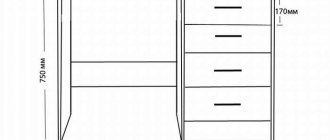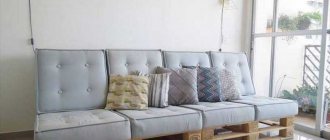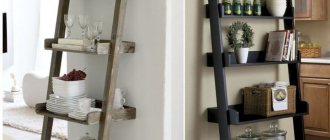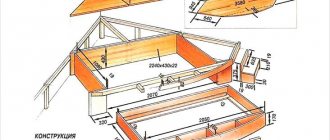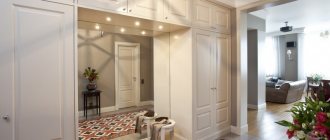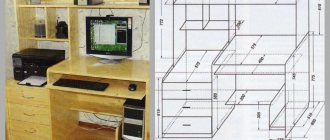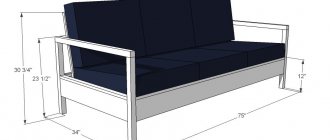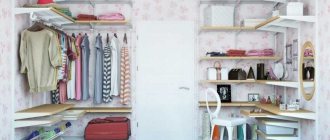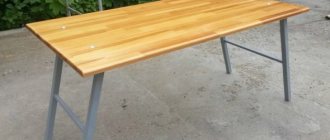Rules for organizing storage of things: basic provisions to help organize the space
The order in which things are placed in the dressing room largely determines the ease of use of the room and the service life of all installed elements. That is why special attention should be paid to the proper organization of the interior space of the dressing room. To do this, a diagram and drawing are developed in advance, which highlight areas intended for storing certain things or objects.
The mounted system should be divided into functional sections, highlighting:
- Lower compartment for shoes, small accessories (umbrellas, bags) and trousers. The height of this area should not exceed 70-80 cm. For shoes, it is worth providing special inclined pull-out shelves. Their height will depend on the purpose. For summer shoes, the height should be about 30 cm, for winter shoes - 40-45 cm;
Shoes should be placed on inclined pull-out shelves
- The middle compartment is for things that are used most often. This area includes pantographs, rods, and pull-out shelves on which small toiletries can be placed. The height of the middle zone depends on the length of the items. The average dimensions are in the range of 1.4-1.7 m. To place jackets and shirts, it is enough to provide a compartment 1 m high. For knitted items, it is worth providing boxes and baskets that can be placed on shelves;
Casual clothing should be affordable
- Top compartment for seasonal items and bulky items. On such racks you can place pillows, blankets, suitcases, large bags, household and sports equipment.
Blankets can be placed higher
When designing a dressing room, you should take care of the presence of innovative components. Using special holders you can place trousers, skirts, belts, ties, scarves, boxes for various small items and much more.
Innovation will help you find a place for every thing
The location of shelves in a sliding wardrobe - what is worth remembering?
In addition to hanging space, shelves are also important. When considering how to decorate your walk-in closet, consider the space for sweaters and sweatshirts—it should be about 50 centimeters wide. Plan your space at eye level - this arrangement of shelves in your closet will give you comfort when planning your style.
Also take care of the top of the furniture. The correct placement of shelves in a closet will allow you to store seasonal accessories, such as swimsuits, ski clothes, as well as rollers or protective films. Too narrow a space at the top of the wardrobe will be impractical.
It is important not only the location of the shelves in the wardrobe, but also the location of the drawers. They should be at the bottom of the furniture, but not near the floor, where shoes are best stored. You can use the drawers for underwear, tops, thin long-sleeve shirts and robes. You can also put towels in them if you don't have enough space on the shelves.
Wardrobe interior - which shelves should you use?
- The design of a dressing room in which the shelves will be at least 50 centimeters wide - allows you to conveniently store sweaters and sweatshirts,
- The shelves should be at eye level - you won't have to lean towards them when using them,
- At the top of the furniture, plan a place for seasonal items - it cannot be too narrow,
- Take care of the arrangement of drawers, which should be located under the shelves.
A sliding wardrobe should be designed with shelves with a minimum width of 50 cm.
Layout of a dressing room with dimensions
A diagram of the future system is developed before work begins. Before the drawing is prepared, it is worth deciding what the layout of the dressing room will be (with dimensions and to scale).
We carry out the diagram and drawing with dimensions
Particular attention is paid to the possible filling of cabinets and dressing rooms, depending on the number of people living and the allocated area. Example of drawings and diagrams of ready-made solutions.
Corner dressing rooms in the hallway
When arranging a dressing room in the hallway, it is worth rationally using the available squares. By giving preference to a corner layout, you can use those places where access is difficult or not rational. For example, the corner adjacent to the window and door opening is often left unused. If you place a dressing room in this place, you can effectively manage the available square footage.
Drawing of a corner dressing room
Depending on what area it is decided to allocate for a dressing room, the layout of the elements of the mounted system and the order of their separation from the main space may change. If the square footage is large, you can develop a drawing and install a plasterboard partition. If the space is relatively small, you should pay attention to an open storage system. Instead of a separate small dressing room, you can install a corner wardrobe. Photos of structures assembled with your own hands can become a clear example when developing your own drawings.
The interior filling of a dressing room, separated from the main space, can be done in different ways: along one wall or both at once. The first solution involves a compact arrangement of all structural elements along one wall. For more economical use of space, shelves and racks are kept open. Free space is sometimes used as a fitting room.
There is a place for fitting
If you want to achieve maximum capacity with comparative compactness, you should use two walls. This scheme is optimal for a family consisting of several people. A set of corner components will ensure sufficient ergonomics of the mounted structure with a limited area. However, it is worth considering that using such a dressing room as a fitting room will not work.
By using two walls, they increase the storage area
Attention! The mounted structure can be fenced off from the rest of the space by installing doors.
Doors will help isolate the structure
Linear type of wardrobe rooms
Such projects are quite popular due to their ease of execution and compactness. The set is located along one wall, allowing you to allocate the smallest possible but sufficient space for placing furniture. The following photos will help you understand the essence of a linear dressing room and the features of developing diagrams and drawings.
Doors are often used to hide the installed structure. It is enough to move the canvas to the side or open it to gain access to things. Photos of possible solutions:
Linear wardrobes often have retractable hangers. It is enough to make a simple movement so that the things stored inside the structure are in an accessible area.
Photo of retractable hangers
Parallel type
Parallel layout is in demand due to its ease of implementation and functionality. To create a dressing room of this type with your own hands, it is enough to have a divided set and a partition. Despite its apparent simplicity, this solution is not always optimal. In some cases, it is worth abandoning it if, for example, the layout of a structure in a remote room is being worked out. For such a room, the best option would be a U-shaped layout, which allows you to more rationally manage the available space. But for a walk-through room, the parallel type is preferable.
The parallel diagram is relevant for a walk-through room
When developing a drawing and diagram, you should take into account the geometric parameters of the future dressing room. The distance between the walls should not be less than 1.6 meters. A smaller width will create serious difficulties when using the room.
The distance between the racks is indicated in the drawing
Attention! The distance between the mounted sides should not be less than 0.8 meters.
Installing end hangers will allow you to optimally manage the available space. It is also possible to install a dressing table and a mirror.
The filling is selected individually
L-shaped walk-in closets
The L-shaped layout has its own specifics. When installing dressing rooms according to this scheme, you can refuse to install any partitions, since the racks are actually part of the room in which they will be located. Considering that the cost of constructing partitions often accounts for 50% of the total cost, by giving preference to this type, you can significantly reduce your costs.
L-shaped are mounted without partitions
This layout is worth paying attention to if you need a dressing room of 2 sq. m. Photos of finished projects indicate that open shelving is most often chosen in order to rationally manage the available space.
U-shaped
Most people refuse to install a U-shaped dressing room in a typical apartment, believing that such a scheme can only be implemented in large areas. However, with the right approach, developing a drawing and diagram, you can intelligently manage even a relatively small space by creating an area for storing things in the corner of one of the rooms.
U-shaped ones will help you rationally manage space
Perhaps such a solution will add extravagance to the created interior, but it will fully meet the requirements of ergonomics. The set itself is made monolithic. To ensure sufficient functionality, it is worth providing closed drawers, hangers, and special sections.
The monolithic headset is ergonomic
If you decide to allocate a whole room, and not just part of it, to arrange a dressing room, you should pay attention to a rectangular room. The elongated shape will simplify the process of developing a diagram and drawing, as well as subsequent installation of the structure with your own hands.
For a U-shaped dressing room, it is worth selecting a rectangular room
Finishing materials
Making a wardrobe has become a real art. To create their masterpieces, designers use all kinds of construction and finishing materials: drywall, glass, mirrors, metal, plastic, chipboard, MDF and others.
The service life of the dressing room directly depends on the choice of materials.
Drywall
It is used for the construction of partitions and false walls, as well as for creating shelving. It is environmentally friendly, plastic, easy to use, quite durable, and does not leave debris or dust during installation.
The photo shows a linear dressing room, separated from the bedroom by a light plasterboard partition
When creating mini-wardrobes in a niche of a room, they often use single paneling instead of double paneling, since heavy objects cannot be hung on drywall, and you will still have to use shelving or make fastenings on strong walls.
Chipboard
Laminated chipboard is a fairly durable, reliable, aesthetic, inexpensive material, but it can emit harmful substances, so you should pay attention to the presence of a quality certificate. It is used to create partitions, doors, shelving, shelves, drawers and modular furniture.
Chipboard structures allow you to beautifully decorate your dressing room without spending a lot of money
This material allows you to save time when creating a partition, in contrast to plasterboard structures, which still need to be puttyed, wallpapered and painted. Also, making partitions and modular furniture from the same material looks quite stylish.
Glass
Glass is used to make not only furniture parts, but also design elements. For example, shelves are made not only from chipboard or wood, but also from glass, and also by combining glass shelves with metal racks that are coated with chrome or nickel. Sliding door systems also contain glass elements in their designs.
The photo shows a built-in wardrobe with sliding doors made of tempered glass, decorated with a beautiful pattern.
Glass can have a matte or glossy surface, it can have sputtering elements, and it can also be transparent or translucent, with or without a pattern. It is impossible to imagine lamps without glass.
Wardrobes in the bedroom
When starting to develop drawings and deciding on the location of the dressing room, attention is most often paid to the bedroom. This place for storing clothes can easily be called the most successful. That is why photos of ready-made solutions most often show a dressing room in the bedroom.
How rational such a solution is for a particular room can be determined at the stage of developing drawings after calculating the area of the sleeping area. If the dimensions of the room allow you to install a bed of the desired size, and there is still some space left, you can safely take on the installation work yourself.
Which scheme for organizing the internal space will be preferred is decided at the stage of drawing development. The best option is considered to be U-shaped, which allows you to fill the shelves as much as possible and provide enough space for movement. However, L-shaped or parallel is often found.
L-shaped system in the bedroom
The design of the corner dressing room in the bedroom deserves special attention. Photos of ready-made solutions show that to implement it, it is enough to install a partition at the head of the bed and separate a small corner. However, this solution is only suitable for rooms with a large area.
Corner dressing room in a large bedroom
Related article:
Wardrobe rooms: design projects, photos . The special publication provides tips on organizing dressing rooms and examples of successful layouts.
Construction of a dressing room from a storage room in a Khrushchev building
If you compare a pantry and a dressing room, the main difference will be in the system for organizing things. The latter provides mezzanines, shelves, hangers, drawers and other components designed for convenient storage of things for various purposes. Thanks to a well-thought-out layout, all things are accessible and visible. The accommodation option depends on the budget and area of the room.
A storage room that can become functional and ergonomic
To make a small walk-in closet from a closet convenient and functional, you should first familiarize yourself with possible planning solutions that are relevant for a small room. Using the latest technologies, it is easy to become the owner of an optimal storage system that can harmoniously fit into the available space. Based on photos of ready-made solutions, it will be possible to initially develop a diagram of the future dressing room, and then a detailed drawing. After this, it will be much easier to assemble and install the structure with your own hands.
We invite you to familiarize yourself with the photo of the dressing room with your own hands from the pantry, which have already been implemented:
Design and selection of furniture
The design of the dressing room must certainly be in harmony with the interior of the room it is adjacent to. For example, wooden shelves are best suited for a classic style, and plastic and metal for a modern high-tech style.
Types of wardrobes, features of filling
There are several tricks for placing such furniture in a small room:
- For a very small dressing room, you can adapt a niche in the wall, the passage to which is covered with curtains or sliding doors.
- If the room is very cramped, the dressing room should be left open, but with a large number of roll-out drawers, shelves, and hangers. An ottoman and a mirror will successfully complement such an interior.
In a small bedroom, racks with casual clothes can be placed behind the headboard.
Furniture designs for dressing rooms are varied, but must be ergonomic and functional, these are:
- tall cabinets without doors;
- racks of different sizes that have a specific purpose: storing shoes, clothes or accessories;
- drawers for underwear or with crossbars for trousers;
- systems for storing raincoats, down jackets, coats, dresses, jackets;
- shelves for storing winter, summer and demi-season shoes;
- vertical spiral hangers for bags and clutches.
For small walk-in closets, modular furniture made of metal is suitable. Also, a mobile structure designed to accommodate various hangers will take up little space in the room. Shoes are placed under it, and hooks for bags are mounted on the sides.
Drawers
Tall cabinets without doors
Shoe storage shelves
Outerwear storage system
Shelving
Spiral hanger
Proper dressing room lighting
The lighting must be good. However, direct sunlight may cause the fabric to discolor. It is worth abandoning natural sources in favor of artificial ones. Don't limit yourself to just one ceiling lamp. Its luminous flux will not be enough.
Additional light sources are required
The best solution is to install a suspended ceiling with spot lighting or install a large number of small lamps located around the perimeter of the installed structure. In the photos of dressing rooms you can see fluorescent lamps mounted on the partitions, allowing for the proper level of illumination.
Fluorescent lamps are very popular
Requirements for dressing room ventilation
To prevent the appearance of a musty smell, good air exchange is organized in places where things are stored. For this purpose, not only natural, but also forced ventilation is provided. The first ensures air movement due to physical processes, which assume that cold air arriving from below rises upward. To implement this, an inlet opening should be provided in the lower part, and an exhaust opening in the upper part. If the ventilation duct runs close to the installed system, it is worth providing a branch to the exhaust vent.
The disadvantage of natural ventilation is the low air exchange rate. The installation of a supply system, which involves installing fans in the supply or exhaust openings, helps to correct the situation. However, most often preference is given to forced exhaust with a natural supply of fresh air.
To ensure that enough fresh air enters the room, the size of the supply openings is determined based on the speed of movement of air masses and the dimensions of the room. In accordance with regulatory documents, a single air exchange must be ensured.
Air exchange must be sufficient
Doors for dressing room
When starting installation yourself, you should decide on the type of doors to be installed. Their dimensions can be calculated from the drawing. The choice can be made in favor of sliding, coupe, accordion, hinged, or hinged ones. Sometimes you can do without them. Photos of dressing rooms behind curtains will tell you how to implement this option.
When choosing doors for a dressing room, you should focus on the width of the opening and the overall stylistic design of the room. The structure being installed must fit harmoniously into the space. The width of the sashes and their design are selected individually.
The design of the sashes may vary
Design nuances depending on the size of the room
When designing, take into account the size of the room. For larger ones, it is more advisable to use a parallel or U-shaped layout, while in a modest-sized bedroom you can install a corner-type design.
The layout of the dressing room consists of several stages:
- Calculate the number of family members who will use the room. Its dimensions will also depend on this (for small children, the height of the shelves should be appropriate).
- Determine what items are planned to be stored here: only wardrobe items or also those that are used occasionally (spare pillows, seasonal clothes, blankets, suitcases, etc.).
- Calculate the number of dress hangers and shelves needed to accommodate clothes.
- Calculate the length of the dresses according to the height of the railing.
The sketch of the dressing room is drawn after all the calculations have been made of the size of the room and clothes, the number of shelves and hangers.
There are standards for the size of storage systems and the basic principles of their location:
- Considering the width of the hangers - from 34 to 51 cm - the depth of the structure should be from 50 to 60 cm. At the same time, the distance between the hangers, which is recommended to be observed, is 2-5 cm. The tighter the dresses and shirts hang in the closet, the worse their ventilation.
- The height of the railing for hangers on which long items will hang is 150 cm, short ones - 100 cm, for trousers - 60 cm. If there are no long items, the railings can be placed one below the other at a distance of approximately 100 cm.
- For roll-out drawers, allow room for extension - approximately 50 cm.
- The distance between the clothes rails and the upper shelves is 4 cm or more.
- The height of the shelves is from 35 to 40 cm, their standard depth is from 40 cm, width is 45–65 cm. Longer shelves require supports to prevent them from bending under the weight of things.
- The height of the retractable shelves is from 35 to 40 cm, the width is from 40 to 70 cm, these dimensions will ensure normal load on the mechanism. The optimal height for such shelves is from 110 to 140 cm, otherwise their use will be inconvenient.
- The width of the passage for closed dressing rooms is 100–120 cm, for other types of layouts it is 80–100 cm. A passage of 50 cm is considered the minimum.
Criteria for choosing doors for dressing rooms, the variety of their designs
To understand how to properly plan a parallel or U-shaped dressing room, you need to take into account the distance between the walls. It is desirable that it be more than 150–160 cm, and the minimum distance between the shelving is 80–85 cm. With a linear arrangement of furniture, the optimal width of the room is 1 m (cabinet depth + size of the hinged door or roll-out drawer + size of the passage). With this calculation, the storage space will be used as efficiently as possible.
Storage systems in the dressing room
The storage system should be chosen more carefully. Not only the arrangement of things during storage, but also the ease of use of the structure depends on this. Photos, drawings and do-it-yourself wardrobe diagrams indicate that there are a large number of ready-made storage systems that are worth getting acquainted with when starting to develop documentation.
Possible storage system layout
Clothing storage systems
For organized storage of clothes, you can use not only drawers or shelves, but also special systems. The choice can be made in favor of skirts or trousers: special guides with transverse slats on which you can store the named wardrobe element.
Skirt box or trouser box for storing things
An alternative to a skirt can be a hanger with several crossbars located one above the other. It may not be very convenient to use, but it costs much less.
A hanger with several crossbars is an alternative to a skirt rack
Men who prefer a business style will be interested in a design designed to store ties.
Tie devices
Related article:
Storage systems for the dressing room . From this review you will learn what types of structures exist, filling options, nuances of the right choice, how to make calculations and independently manufacture storage systems.
Shoe storage systems
Various systems are designed for storing things. The choice can be made in favor of:
- Pins with modules for shoes;
- Mini chests of drawers;
- Hanging organizers;
- Special grids.
Attention! The choice of system depends on the type and size of shoes stored.
There are different ways to store shoes
Description of designs
The main designs can be divided into:
- Corpus. In the photo, the DIY wardrobe systems are modular. These include side, top and bottom walls. The sections are located close to each other. Budget decision;
- Panel. The basis is a decorative panel rigidly fixed to the wall, on which various storage elements are attached. Expensive option;
- Frame. They consist of metal guide posts on which various fasteners are located, designed to hold storage containers;
- Mesh (cellular). Universal type. The basis is a horizontally located supporting rail, to which guide rails are attached, designed to accommodate shelves, baskets or hangers.
Mesh design – a universal solution
Where to buy: prices for popular models
Before purchasing ready-made systems, we suggest that you familiarize yourself with the average prices for the most popular models:
| Photo | Model/manufacturer | Average price, rub. |
| Children's / ELFA | 43300 |
Children's ELFA
| Photo | Model/manufacturer | Average price, rub. |
| Pantry / ELFA | 55800 |
Pantry ELFA
| Photo | Model/manufacturer | Average price, rub. |
| Dressing room / ELFA | 47400 |
Wardrobe ELFA
| Photo | Model/manufacturer | Average price, rub. |
| Elvarli / Ikea | 20950 | |
| Algot / Ikea | 15420 | |
| Dressing room No. 34 | 20200 |
Dressing room No. 34
Self-installation
The procedure for performing installation work depends on the features of a particular design. Installation of the ELFA system can be performed in the following sequence:
| Photo | Description of work |
| Fastening the upper guide rail on which the remaining elements will be hung. | |
| Mounted guides are placed in accordance with the selected diagram and drawings. The guides are not attached. | |
| Installation of remaining elements. |
Custom cabinets - why choose them?
Prefab cabinets are still popular. They are characterized by low price, great variety and easy availability. You can easily match them to your decor thanks to a huge selection of colors and materials. Ready-made models can be found in any furniture store, but this will not always be the best solution.
A custom-made cabinet has an advantage over a ready-made one, one that perfectly meets your expectations. You won't find it in the nearest furniture store in a few tens of minutes, but rushing is not conducive to making the right purchasing decisions. Designing a wardrobe and then having it made by a professional is a longer process, but the results will certainly please you.
Custom walk-in closets are a great solution for small apartments where every inch, even the smallest nooks and crannies, matters. The furniture will also be well suited for large houses with sloping walls.
It may be that the finished model leaves large, unsightly gaps - built-in wardrobes do not cause this problem. Designs can accommodate various differences between ceiling heights, thereby leaving no room for dust to accumulate and providing space for seasonal items.
The interior of the wardrobe , made by you, will allow you to take into account the needs of each family member. Before ordering the work, the specialist will think about how many shelves or cabinets will be needed. You decide what width is best. You'll also be wondering if there should be room in your closet for more than clothes. A spacious, sized wardrobe will make you forget about various problems, such as sharp slopes or high ceilings.
Custom-made wardrobe - why should you choose this option?
- You will customize the furniture to suit the needs of the family,
- You choose the number of shelves or drawers,
- You'll be planning space for more than clothes.
A custom-made wardrobe allows you to select furniture to suit your family’s needs.
DIY dressing room: diagrams, drawings and photos
Ready-made design projects for dressing rooms may not always fit into the allotted space. In this case, you can assemble the required system with your own hands, having previously prepared the necessary tools, materials, and also developed a diagram and drawings.
How to make a dressing room with your own hands: detailed instructions
To become the owner of a unique system, it is better to do all the work yourself. How to make a dressing room with your own hands from a pantry, increasing the area? You can follow the following instructions:
| Photo | Description of work |
| We remove everything from the pantry. We demolish the doorway. | |
| We install 100 mm wide guides under the foam blocks. | |
| We lay foam blocks. | |
| We are preparing the floor and walls for finishing work. We do the finishing. | |
| We provide a hole for ventilation, which will then be decorated with a grille. | |
| You can arrange the room. We assemble and install furniture, focusing on drawings and diagrams. |
Dressing room design projects: photos of interesting ideas
When independently developing a design project for a dressing room, photos of ready-made solutions help you find a suitable option. The main thing is to decide what system will be installed and what things it will be used to store. We invite you to pay attention to the following photos, which can be used as an idea when developing a drawing or diagram:
Built-in wardrobe - how much space does it need?
Custom cabinets are extremely often placed in a niche. Thanks to this, you can better use the space of the apartment. However, the notch must be of the correct dimensions.
The most important measurement is the depth, which should be about 65 centimeters . This makes the built-in wardrobe ideal for storing clothes on hangers. A shallower depth can result in unsightly creases on jackets or shirts. If the alcove has a custom-made wardrobe, consider the thickness of the fronts to choose the correct depth of furniture.
When it comes to width, there are many options. Of course, the more you can spend on furniture, the better. If you don't have a lot of space to develop, the right wardrobe design will allow you to enjoy a functional piece of equipment.
Many people choose a piece of furniture hidden under the stairs. When considering how to decorate the interior of a wardrobe in a hallway hidden in this way, you should take into account its height. It may turn out that there will be little space. If you don't want to worry about wrinkled dresses or coats, make sure your hangers hang at a height of about 160 centimeters.
